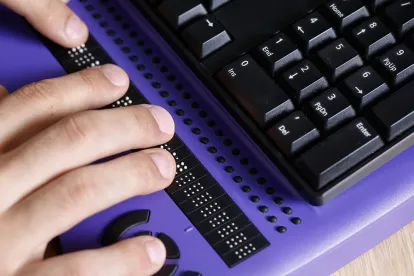Part 1 of our accessibility series explored the importance of businesses deploying accessible IT to recruit and retain employees with a view to reducing job polarization and inequality. Part 2 described how national equality laws are imposing affirmative obligations on businesses to make “reasonable accommodations” in the workplace for employees with disabilities — which may include ensuring that IT devices and services are enabled with accessibility functions.
This third instalment in our series looks deeper into the compliance landscape, at global rules and standards in the U.S., EU and beyond. Although many of these standards currently apply to public sector entities, rather than private entities, we expect this to change as technology transforms the nature of the workplace — not only within back offices and factories, but also on the front-line for customer-facing operations, in sectors such as the hospitality industry and retail.
The important role of industry standards
There is a growing body of global industry standards — such as version 2.0 of the Web Content Accessibility Guidelines (“WCAG 2.0 Guidelines”), Section 508 of the Rehabilitation Act of 1973 (“Section 508”) in the U.S., and EN 301 549 in the EU — that help to benchmark industry expectations for what qualifies as accessible IT.
International standard
The WCAG 2.0 Guidelines are commonly used by companies in countries around the world (and in the U.S., with respect to the determining compliance with the Americans with Disabilities Act 1990 (“ADA”)) as a reliable marker to determine whether websites and other online content are accessible to individuals with disabilities. The WCAG 2.0 Guidelines provide a wide range of testable “success criteria” for determining whether a website or other online content is adequately accessible. These criteria are designed to ensure that web content is perceptible to, operable by, and understandable by persons with disabilities, and that such content is accessible using a wide range of assistive technologies. The WCAG 2.0 Guidelines assign labels for accessibility compliance based on the level of conformance with the WCAG 2.0 Guidelines’ success criteria (from “Level A” for the lowest level of conformance to “Level AAA” for the highest). Although the WCAG 2.0 Guidelines are voluntary as a technical matter, the failure to make websites WCAG 2.0-compliant could increase a company’s exposure to ADA lawsuits by consumer groups and by the plaintiffs’ bar. In recent years, several large companies have entered into agreements to settle ADA lawsuits challenging the accessibility of their online content. Remedies obtained through these settlements have included WCAG 2.0 compliance commitments, enhanced customer assistance obligations, multi-year reporting requirements, and attorneys’ fees (the amount of which is often undisclosed).
U.S. standard
Section 508, for which new regulatory standards came into effect January 18, 2018, requires U.S. federal agencies, when developing, procuring, maintaining, or using IT, to ensure that such technology is accessible to federal employees and to members of the public who have disabilities, unless doing so would be unduly burdensome. Rules promulgated under this statute set forth specific technological and performance-based requirements for satisfaction of the Section 508 standards. Recently, the U.S. Government has undertaken efforts to harmonize Section 508 with other international accessibility regimes. This synchronization of standards is indicative of a growing trend: in January 2017, the U.S. Access Board, an independent federal agency devoted to accessibility issues, updated its standards for IT, in part to align its standards with those relating to IT accessibility that have been developed worldwide (including EN 301 549), and to require all Section 508-covered IT to satisfy the Level A and Level AA WCAG 2.0 success criteria and conformance requirements. The European Commission has also noted that EN 301 549 is “well harmonized with the US standards under US Section 508 of the Rehabilitation Act.” As standards become more aligned across the global landscape, multinational firms should find it increasingly easy to introduce accessible technologies across their businesses.
EU standard
EN 301 549 is designed to be incorporated into public procurement legislation throughout the EU. Its aim in the short-term is to achieve a high benchmark of IT accessibility across the public sector, and in the longer-term to drive greater accessibility for society as a whole. The standard is the result of a mandate given by the European Commission to the European standards groups, CEN, CENELEC and ETSI (“Mandate 376”). It provides “in a single source, detailed, practical and quantifiable functional accessibility requirements that take note of global initiatives in that field and which are applicable to all IT products . . . and usable in public procurement.”
The standard itself is divided into multiple sections, which encompass both functional performance and more specific requirements. The functional performance requirements require technology to be usable for the vision impaired, the hearing impaired, individuals with limited manipulation and limited reach, those who experience photosensitive seizures, and so on. In addition, a series of specific provisions apply to IT with two-way voice communication, IT with video capabilities, hardware, software and web pages. These include ensuring that all voice communication software also contains a real time text functionality (which allows users to type the content rather than communicate via speech) and introducing requirements about the physical placement of hardware to ensure that users with limited reach can still access the computer.
While the goals of both EN 301 549 and Section 508 are closely aligned, adherence to EN 301 549 is currently voluntary. Compliance with this standard can be demonstrated in various ways — from simple self-declaration (with or without supporting documentation) to accreditation by an independent third party.
Implementation
In terms of implementation of the standard in the laws of EU Member States, uptake has been relatively slow. That may be about to change, however, with the recent EU proposal for a new “European Accessibility Act” (currently progressing through the European legislative process), which will introduce new accessibility obligations on the product and service providers identified in the legislation (these include providers of computer hardware and operating systems). It is possible that once adopted, the European Commission will identify adherence to EN 301 549 as one way that a service provider can demonstrate compliance with the Act’s obligations.
EN 301 549 is also widely recognized by disability groups as a reliable indicator of an IT provider’s accessibility credentials. Groups like the European Disability Forum, the European Blind Union and G3ict, the Global Initiative for Inclusive Information and Communications Technologies, have given their support to the standard and its use, particularly in the public procurement space.
These industry standards are often used in the public procurement context — for example, when public bodies assess whether companies that submit tender bids meet the basic IT accessibility standards set out in technical specifications. For example, the Swedish Post and Telecom Authority both participated in the production of EN 301 549 and now endorses its use in public procurement of IT products in Sweden. In a similar vein, the Portal Administración electrónica in Spain (the Spanish government’s electronic portal) promotes the use of EN 301 549 and provides a series of training materials for public sector institutions to use to assist when implementing the standard. Beyond the EU and the U.S., in December 2016, the Australian Standards body, which develops and adopts standard in Australia, formally adopted the EN 301 549 standard as an Australian standard, noting that “The standard will mirror European Standard EN 301 549 and be consistent with the US Section 508 and WCAG 2.0.” Although not mandatory for Australian government organizations to adopt when entering into IT public procurement, it is anticipated that federal, state and local government bodies in Australia will reference the standard in their procurement policies. Local education institutions, like New South Wales Department of Education, are leveraging existing technologies to adhere to such IT procurement standards and meet the needs of its students.
Although these standards are currently widely used in the public sector, private sector uptake has been slower. Employers should consider imposing similar expectations for their own IT providers. Requiring providers to demonstrate that their solutions comply with these standards can assist organizations in more easily and meaningfully assessing IT accessibility and creating solid internal and external policies around the use and procurement of IT products and services.






 />i
/>i
